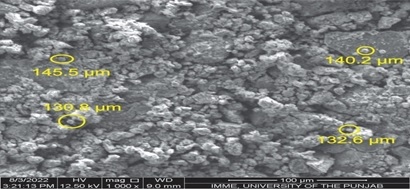Synthesis and Characterization of Highly Crystalline Strontium Metal-Organic Frameworks using 1,4-Benzenedicarboxylic Acid (BDC) Organic Linker
Abstract
 Abstract Views: 0
Abstract Views: 0
In this work, strontium Metal Organic Framework (MOF) using 1,4-benzenedicarboxylic acid (BDC) as the organic linker has been synthesized and characterized. Several industries, such as catalysis, gas storage, and medicinal delivery, have shown interest in strontium metal-organic frameworks (MOFs). Synthesis involves a solvothermal procedure where a controlled reaction environment in which strontium ions are coordinated with BDC ligands, leads to the creation of porous crystalline MOF structures. Various analytical methods were used to characterize the synthesized Sr-MOF. These methods included X-ray diffraction (XRD), scanning electron microscopy (SEM), and Fourier-transform infrared spectroscopy (FTIR), and electron dispersive X-ray spectroscopy (EDX). Strontium metal-organic frameworks with different structural characteristics have been successfully formed, as evidenced by the characterization results. Also, learning about the solvents employed for reaction requirements. By expanding our understanding of Sr-MOF materials and their properties, this study paves the way for future investigations in materials science and chemistry.
Downloads
References
Prinz N, Strübbe S, Bauer M, Zobel M. Structural transitions during Ni nanoparticle formation by decomposition of a Ni-containing metal–organic framework using in situ total scattering. New J Chem. 2023;47(24):11623–11635. https://doi.org/10.1039/D3NJ00493G
Devi B, Kurungot S. Conductive metal-organic frameworks for zinc-air battery application: design principles, recent trends and prospects. J Mater Chem A. 2024;12(5):2605–2619 https://doi.org/10.1039/D3TA03753C
Adil M, Olabi AG, Abdelkareem MA, et al. In-situ grown metal-organic framework derived CoS-MXene pseudocapacitive asymmetric supercapacitors. J Energy Storage. 2023;60:e106537. https://doi.org/10.1016/j.est.2022.106537
Saeed G, Alam A, Bandyopadhyay P, Jeong S, Kim K, Lim S. Metal-organic framework-derived (Mn-1) CoxSy@(Ni–Cu) OHs marigold flower-like core@ shell as cathode and (Mn–Fe10) Sx@ graphene–foam as anode materials for ultra-high energy-density asymmetric supercapacitor. Mater Today Chem. 2022;23:e100758. https://doi.org/10.1016/j.mtchem.2021.100758
Ghatak A, Shanker GS, Sappati S, Liberman I, Shimoni R, Hod I. Pendant proton‐relays systematically tune the rate and selectivity of electrocatalytic ammonia generation in a fe‐porphyrin based metal‐organic framework. Angew Chem, Int Ed. 2024:e202407667. https://doi.org/10.1002/anie.202407667
Thakur AK, Majumder M, Patole SP, Zaghib K, Reddy M. Metal–organic framework-based materials: advances, exploits, and challenges in promoting post Li-ion battery technologies. Mater Adv. 2021;2(8):2457–2482. https://doi.org/10.1039/D0MA01019G
Feng D, Zhou L, White TJ, Cheetham AK, Ma T, Wei F. Nanoengineering metal–organic frameworks and derivatives for electrosynthesis of ammonia. Nano-Micro Lett. 2023;15(1):e203. https://doi.org/10.1007/s40820-023-01169-4
Kalaj M, Bentz KC, Ayala Jr S, et al. MOF-polymer hybrid materials: From simple composites to tailored architectures. Chem Rev. 2020;120(16):8267–8302. https://doi.org/10.1021/acs.chemrev.9b00575
Zhang X, Wan K, Subramanian P, Xu M, Luo J, Fransaer J. Electrochemical deposition of metal–organic framework films and their applications. J Mater Chem A. 2020;8(16):7569–7587. https://doi.org/10.1039/D0TA00406E
Nabipour H, Mozafari M, Hu Y. BioMOFs. In: Mozafari M, ed. Metal-Organic Frameworks for Biomedical Applications. Elsevier; 2020:321–345. https://doi.org/10.1016/B978-0-12-816984-1.00017-2
Tranchemontagne DJ, Hunt JR, Yaghi OM. Room temperature synthesis of metal-organic frameworks: MOF-5, MOF-74, MOF-177, MOF-199, and IRMOF-0. Tetrahedron. 2008;64(36):8553–8557. https://doi.org/10.1016/j.tet.2008.06.036
Safaei M, Foroughi MM, Ebrahimpoor N, Jahani S, Omidi A, Khatami M. A review on metal-organic frameworks: synthesis and applications. TrAC Trends Anal Chem. 2019;118:401–425. https://doi.org/10.1016/j.trac.2019.06.007
Furukawa H, Cordova KE, O’Keeffe M, Yaghi OM. The chemistry and applications of metal-organic frameworks. Science. 2013;341(6149):e1230444. https://doi.org/10.1126/science.1230444
Pathak I, Acharya D, Chhetri K, et al. Ti 3 C 2 T x MXene embedded metal–organic framework-based porous electrospun carbon nanofibers as a freestanding electrode for supercapacitors. J Mater Chem A. 2023;11(10):5001–5014. https://doi.org/10.1039/D2TA09726E
Wei R, Liu X, Zhou Z, et al. Carbon nanotube supported oriented metal organic framework membrane for effective ethylene/ethane separation. Sci Adv. 2022;8(7):eabm6741. https://doi.org/10.1126/sciadv.abm6741
Tsai M-D, Chen Y-L, Chang J-W, Yang S-C, Kung C-W. Sulfonate-functionalized two-dimensional metal–organic framework as a “dispersant” for polyaniline to boost its electrochemical capacitive performance. ACS Appl Energy Mater. 2023;6(21):11268–11277. https://doi.org/10.1021/acsaem.3c02155
Li W. Metal–organic framework membranes: production, modification, and applications. Prog Mater Sci. 2019;100:21–63. https://doi.org/10.1016/j.pmatsci.2018.09.003
Bai S, Liu X, Zhu K, Wu S, Zhou H. Metal–organic framework-based separator for lithium–sulfur batteries. Nat Energy. 2016;1(7):1–6. https://doi.org/10.1038/nenergy.2016.94
Lee J, Farha OK, Roberts J, Scheidt KA, Nguyen ST, Hupp JT. Metal–organic framework materials as catalysts. Chem Soc Rev. 2009;38(5):1450–1459. https://doi.org/10.1039/B807080F
Gangu KK, Maddila S, Mukkamala SB, Jonnalagadda SB. A review on contemporary metal–organic framework materials. Inorg Chimica Acta. 2016;446:61–74. https://doi.org/10.1016/j.ica.2016.02.062
Yin LL, Kong XY, Zhang Y, Ji YQ. Facile synthesis of the magnetic metal organic framework Fe3O4@ UiO-66-NH2 for separation of strontium. Biomed Environ Sci. 2018;31(6):483–488. https://doi.org/10.1016/j.ica.2016.02.062
Petit C, Burress J, Bandosz TJ. The synthesis and characterization of copper-based metal–organic framework/graphite oxide composites. Carbon. 2011;49(2):563–572. https://doi.org/10.1016/j.carbon.2010.09.059
Laurier KG, Vermoortele F, Ameloot R, De Vos DE, Hofkens J, Roeffaers MB. Iron (III)-based metal–organic frameworks as visible light photocatalysts. J Am Chem Soc. 2013;135(39):14488–14491. https://doi.org/10.1021/ja405086e
Hu X, Hu H, Li C, et al. Cobalt-based metal organic framework with superior lithium anodic performance. J Solid State Chem. 2016;242:71–76. https://doi.org/10.1016/j.jssc.2016.07.021
Banerjee D, Kim SJ, Parise JB. Lithium based metal− organic framework with exceptional stability. Cryst Growth Des. 2009;9(5):2500–2503. https://doi.org/10.1021/cg8014157
Hauptvogel IM, Biedermann R, Klein N, et al. Flexible and hydrophobic Zn-based metal–organic framework. Inorg Chem. 2011;50(17):8367–8374. https://doi.org/10.1021/ic200937u
Tavakolinia F, Yousefi M, Afghahi SSS, Baghshahi S, Samadi S. Synthesis of novel hard/soft ferrite composites particles with improved magnetic properties and exchange coupling. Proc Appl Ceram. 2018;12(3):248–256. https://doi.org/10.2298/PAC1803248T

Copyright (c) 2025 Ezaz Haider Gilani, Rashid Mehmood, Hifsa Jamil

This work is licensed under a Creative Commons Attribution 4.0 International License.





